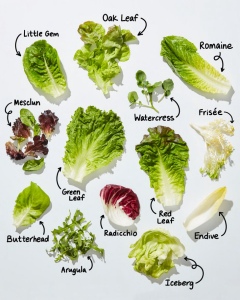Lettuce is the third most consumed vegetable in the United States. There are over 800 varieties of lettuce in America, the most common are shown in the picture:

FAST FACTS
Benefits and nutritional information:
- Lettuce is not eaten for its nutritional content, although it does contain significant levels of vitamins and minerals. Nonetheless, it is 95% water and very low in calories.
Starting:
- Lettuce seeds are sown directly into garden rows.
- The seeds are quite small and care must be taken not to plant too many of them since it makes the job of thinning difficult.
- One recommendation is to mix the seeds with fine, dry soil before sowing.
- Seeds should be planted 1/4” deep, in rows 24” apart.
When to plant:
- Lettuce is among the first vegetables to be planted in our area.
- The seeds can germinate when soil temperature is 35 degrees, and it has a 70% germination rate at only 45 degrees.
- Seeds can be planted about once a month for a steady supply.
- Summer planting will yield leaves that taste bitter, and the plants are prone to bolting.
- Lettuce grows well with cucumbers, carrots and radishes.
Thinning, training
- As plants begin to grow, thin out smaller, weaker ones.
- Eventually spacing of lettuce plants should be 8” to 12”.
Signs of over-watering, nutrient deficiency
- Lettuce requires a constant supply of water while growing;
- however, soil that’s waterlogged with prevent roots from absorbing water or nutrients and the plants will die out.
- With its shallow root system, lettuce may benefit from an extra application of a balanced (5-5-5) fertilizer every 3 weeks or so once it begins producing a crop.
Pests and pest controls
- Insect pests include Aphids, Flea Beatles, Cutworms, Thrips, and Slugs.
- Slugs are the most aggressive and troublesome on lettuce.
- Diseases: Damping-off disease, Downy Mildew, Leaf Spot
Harvesting
- With leaf lettuce, you can harvest outer leaves and the plant will continue to grow and re-sprout more leaves.
